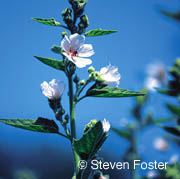Marshmallow
Marshmallow (Althea officinalis) -- the herb, not the white puffy confection roasted over a campfire -- has been used for more than 2,000 years as both a food and a medicine. The Romans, Chinese, Egyptians, and Syrians used marshmallow as a source of food. The Arabs made poultices from its leaves and applied them to the skin to reduce inflammation. Both the root and leaves contain a gummy substance called mucilage. When mixed with water, it forms a slick gel that is used to coat the throat and stomach to reduce irritation. It is also applied topically to soothe chapped skin.
Few scientific studies have looked at the effects of marshmallow in humans. Most of its suggested uses come from a long history of use in traditional healing systems. However, one recent study confirmed that marshmallow preparations help soothe irritated mucous membranes due to:
- Asthma
- Bronchitis
- Common cold/sore throat
- Cough
- Inflammatory bowel diseases (such as Crohn's disease and ulcerative colitis)
- Indigestion
- Stomach ulcers
- Skin inflammation
Plant Description
Marshmallow originally grew in salty soils. But now it thrives in moist, uncultivated ground. It is found in southern and western Europe, western Asia, and the northeastern region of North America. Its fleshy, upright stems reach heights of 3 to 4 feet.
The pale yellow roots are tapered, long, and thick, with a tough, yet flexible exterior. The short-stemmed leaves are round, with irregularly toothed margins and 3 to 5 lobes. A soft and velvety down covers the leaves and stem. The flowers have 5 reddish white petals. The whole plant, especially the root, is filled with mild mucilage.
Parts Used
The leaves and roots of marshmallow are the parts used for medicinal purposes.
Available Forms
Dried leaves may be used in infusions, fluid extracts, and tinctures. Marshmallow roots are available dried, peeled, or unpeeled in extracts (dry and fluid), tinctures, capsules, ointments, creams, and cough syrups.
How to Take It
PediatricThere is no data to suggest what dose is appropriate for a child. Ask your child's pediatrician for guidance.
AdultMarshmallow root is available as a tea, liquid tincture, or capsule. Drink several cups of tea daily, drink 1 glass of water containing 30 to 40 drops of tincutre daily, or take capsules containing an equivalent of 6g of powdered root daily in divided doses.
Precautions
The use of herbs is a time-honored approach to strengthening the body and treating disease. However, herbs can trigger side effects, and can interact with other herbs, supplements, or medications. For these reasons, you should take herbs with care, under the supervision of a health care provider.
Marshmallow is generally considered safe. It has no reported side effects. It appears to be safe for use during pregnancy and breastfeeding, although you should check with your doctor before taking it.
One study suggests marshmallow may lower blood sugar levels. So people with diabetes should talk to their doctors before taking marshmallow.
Possible Interactions
Marshmallow coats the lining of the stomach. So it may interfere with the absorption of other drugs or herbs. To avoid any problems, take marshmallow several hours before or after taking other herbs or medications.
- Lithium. Marshmallow may increase the amount of lithium in the body, thereby increasing the risk of side effects.
- Diabetes drugs. Marshmallow may decrease blood sugar. Taking diabetes medications along with marshmallow may result in your blood sugar going too low.
Supporting Research
Basch E, Ulbricht C, Hammerness P, Vora M. Marshmallow (Althaea officinalis L.) monograph. J Herb Pharmacother. 2003;3(3):71-81.
Buechi S, Vogelin R, von Eiff MM, Ramos M, Melzer J. Open trial to assess aspects of safety and efficacy of a combined herbal cough syrup with ivy and thyme. Forsch Komplementarmed Klass Naturheilkd. 2005;12(6):328-332.
Blumenthal M, Goldberg A, Brinckmann J. Herbal Medicine: Expanded Commission E Monographs. Newton, MA: Integrative Medicine Communications; 2000:244-248.
Brinker F, ed. Herb Contraindications and Drug Interactions. 2nd ed. Sandy, OR: Eclectic Medical Publications; 1998:99.
Curnow A, Owen SJ. An Evaluation of Root Phytochemicals Derived from Althea officinalis (Marhsmallow) and Astragalus membranaceus as Potential Natural Components of UV Protecting Dermatological Formulations. Oxid Med Cell Longev. 2016; 2016:7053897.
Drake PM, de Moraes Madeira L, Szeto TH, Ma JK. Transformation of Althaea officinalis L. by Agrobacterium rhizogenes for the production of transgenic roots expressing the anti-HIV microbicide cyanovirin-N. Transgenic Res. 2013;22(6):1225-1229.
Franz G. Polysaccharides in pharmacy. Current applications and future concepts. Planta Med. 1989;55:493-497.
Newall C, Anderson L, Phillipson J, eds. Herbal Medicines: A Guide for Health-care Professionals. London, England: Pharmaceutical Press; 1996:188.
Nosál'ova G, Strapková A, Kardösová A, Capek P, Zathurecký L, Bukovská E. [Antitussive action of extracts and polysaccharides of marsh mallow (Althea officinalis L., var. robusta)] [German]. Pharmazie. 1992;47(3):224-226.
Rakel D, ed. Integrative Medicine. 3rd ed. Philadelphia, PA: Elsevier Saunders; 2012.
Schulz V, Hansel R, Tyler V. Rational Phytotherapy: A Physicians' Guide to Herbal Medicine. 4th ed. Berlin, Germany: Springer; 2000:29,182.
Sutovska M, Nosalova G, Franova S, Kardosova A. The antitussive activity of polysaccharides from Althaea officinalis l., var. Robusta, Arctium lappa L., var. Herkules, and Prunus persica L., Batsch. Bratisl Lek Listy. 2007;108(2):93-99.
Reviewed By
Steven D. Ehrlich, NMD, Solutions Acupuncture, a private practice specializing in complementary and alternative medicine, Phoenix, AZ. Review provided by VeriMed Healthcare Network. Also reviewed by the A.D.A.M Editorial team.

 All rights reserved.
All rights reserved.